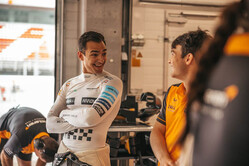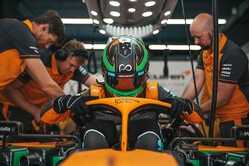


26/09/2022
NEWS STORY
 Spanish IndyCar racer, Alex Palou admits his first experience at the wheel of an F1 car lived up to expectations.
Spanish IndyCar racer, Alex Palou admits his first experience at the wheel of an F1 car lived up to expectations.
Palou joined fellow IndyCar racer, Pato O'Ward at Barcelona where the pair drove the 2020 MCL35M as part of McLaren's TPC (Testing of Previous Cars) programme. Between them the pair completed 267 laps of the Circuit de Barcelona-Catalunya, whilst undertaking a mixture of long and short runs.
"Unreal, really special," said the 25-year-old Spaniard, just days after winning the 2022 IndyCar finale. "This has been a dream of mine since I was a little kid. I didn't think that I would ever have the chance to drive an F1 car, so to have the opportunity to drive one is really special. On top of that, getting to drive it at home makes it twice as special.
"I grew up coming to this circuit and visiting the testing days with my dad," he continued, "so being able to drive an F1 car around Barcelona has been pretty special.
"I have been lucky enough to race in Europe, Japan, and the US, but it is great to come back to Europe and learn from an F1 team. There is so much that I can learn, and I cannot wait to continue."
Palou has spent the past three years racing in IndyCar, winning the 2021 championship title with three victories, seven podiums and two poles, prior to that he enjoyed race-winning experience in Super Formula, GP3 and Euro Formula Open.
"I tried to prepare myself as much as possible, but at the same time, I don't think I could have prepared for this without having driven a car before, but now I know what I need to do to prepare. I just wanted to have fun and embrace every moment."
Asked what surprised him the most about the F1 experience, he said: "Everything! I would probably say the level of grip and the general capability of the car, being able to brake so late and still having amazing balance on the corners.
"The car is super-fast, and of course, I am impressed by how fast these cars can go, but you kind of get used to that. The level of grip, however, even after 100 laps, my body would still tell me every time I approach a corner, 'no, no, no, there is no way', but you can do it, and even more.
"Power-wise, it is crazy," he added, "the amount of power, the grip, and the downforce is insane. Weight-wise, I think it is similar, but you go so fast, and there is so much downforce. We have power steering in F1, but we don't in IndyCar, which makes a big difference.
"They are both physically demanding, but in different ways. An F1 car is more about strength in the neck and the g-forces, but it is easier on the arms. In INDYCAR, it is so demanding on your arms but easier on your neck.
"The amount of detail on the F1 cars is insane. So to start with, it was just about getting comfortable with the speed and downforce."
 "It is basically a rocket ship on wheels," said O'Ward. "They are works of art, and great pieces of engineering, so much work and resource go into the development of these cars, and you can really feel that."
"It is basically a rocket ship on wheels," said O'Ward. "They are works of art, and great pieces of engineering, so much work and resource go into the development of these cars, and you can really feel that."
After two F1 tests the Mexican feels he's getting to grips with the differences between the two cars.
"It is important to know where the wind is coming from with these types of cars," he explained. "They're so dependent on wind direction because they're so dependent on aerodynamic balance. That is new compared to what I am used to with Indycar because the air is somewhat important, but not that much.
"In the F1 car, it seems to make quite a large balance shift, especially throughout a high-fuel run, so I think that will take some time to get used to. I am just trying to be proactive inside of the car.
"I am just trying to further my knowledge," he said of the test. "Seeing what the car likes and what it doesn't, looking at how you can gain lap time with this car on a quali run as opposed to a higher-fuel run.
"Ultimate lap time comes from knowing the car that bit more and knowing what you can get away with in the first half of the lap in order to still have some tyre left by the end of it. I think the biggest improvements come from the realisation of where you can push the car, even on a high-fuel run, and where you have to give in a bit to make the tyres last longer.
"I need to improve in every single aspect because this is still very new to me. I feel like I have made very significant steps every single time I have gotten into the car, but there is still more to come in every single area."
Phil Thomas, McLaren's lead TPC engineer for the test, said he was impressed by how quickly the two drivers adapted, praising their efforts.
"I have been impressed by their commitment," he said. "They have both been working really hard and were excited for the opportunity. They have both made the most of it, and I am impressed with what they have done so far. They got up to speed quickly on the first day, and that allowed the engineers to push their performances on the second day.
"These tests are about more than just learning the cars - they must learn how to use them in different conditions. They got to do some qualifying runs, some race runs, and some practice runs. It's the variety that will benefit them more than anything. They got stuck into the detailed improvements of driving and made really good progress."